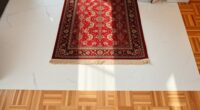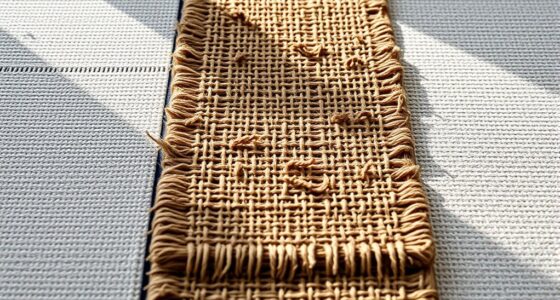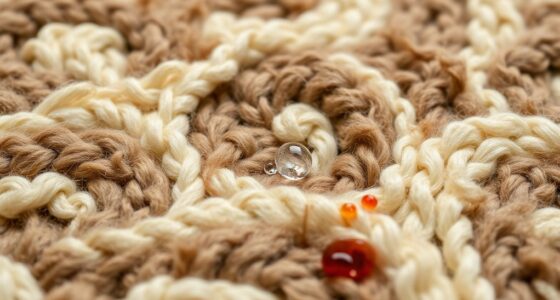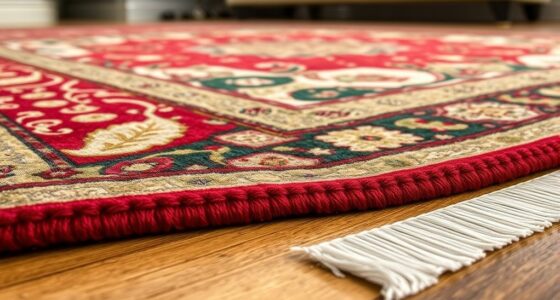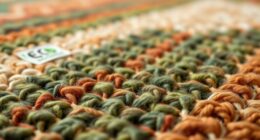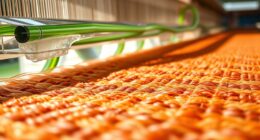At a microscopic level, silk fibers create their beautiful sheen through the layered cuticle structures and tightly aligned fibroin molecules that influence how light interacts with the surface. The scales on the fiber surface reflect, refract, and scatter light, producing a shimmering effect with depth and vibrancy. Fiber thickness and smoothness also play key roles in how light plays across the rug, giving it that distinctive silk glow. Keep exploring to uncover more about this fascinating micro-world.
Key Takeaways
- Microscopically, tightly packed fibroin fibers with layered cuticle structures create specific light reflection and refraction effects.
- Surface microstructures, including scale size and pattern, influence how light interacts, producing silk’s characteristic sheen.
- Fiber orientation and surface smoothness affect light scattering, reflection, and the depth of the silk’s luminous appearance.
- Variations in fiber thickness and surface irregularities modulate the intensity and quality of light play across the fiber surface.
- Dye penetration and microstructural features collectively impact how light interacts within fibers, enhancing vibrancy and visual depth.
The Composition of Silk Fibers
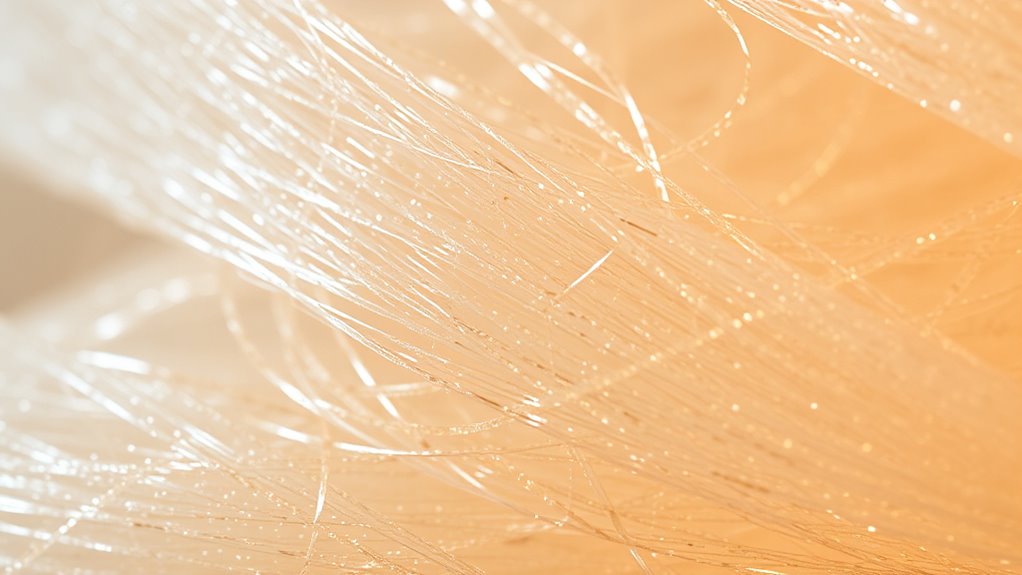
Silk fibers are primarily composed of a protein called fibroin, which gives silk its strength and smooth texture. This protein’s structure allows dye molecules to penetrate easily, resulting in vibrant and uniform colorations. This unique molecular arrangement also contributes to silk’s exceptional durability, supporting its longevity. This durability is further enhanced by the molecular alignment within the fibroin structure, which helps resist environmental stressors. The tight, ordered arrangement of fibroin fibers contributes to the fiber’s exceptional durability, enhancing fiber strengthening over time. When dyes are applied, their ability to deeply penetrate the fiber ensures rich, consistent hues, highlighting silk’s natural luster. Additionally, the molecular structure of fibroin makes silk resistant to wear, supporting its longevity. The molecular composition of fibroin also influences how silk interacts with light, giving it a distinctive sheen that adds to its luxurious appearance. The combination of these structural features not only improves the appearance of silk but also its functional resilience. The unique composition of fibroin also makes silk resistant to wear, supporting its longevity. As you examine silk up close, you’ll notice how its molecular arrangement not only influences color absorption but also underpins its resilience, making silk a prized material for luxurious textiles with enduring quality.
Surface Structure and Scale Arrangement
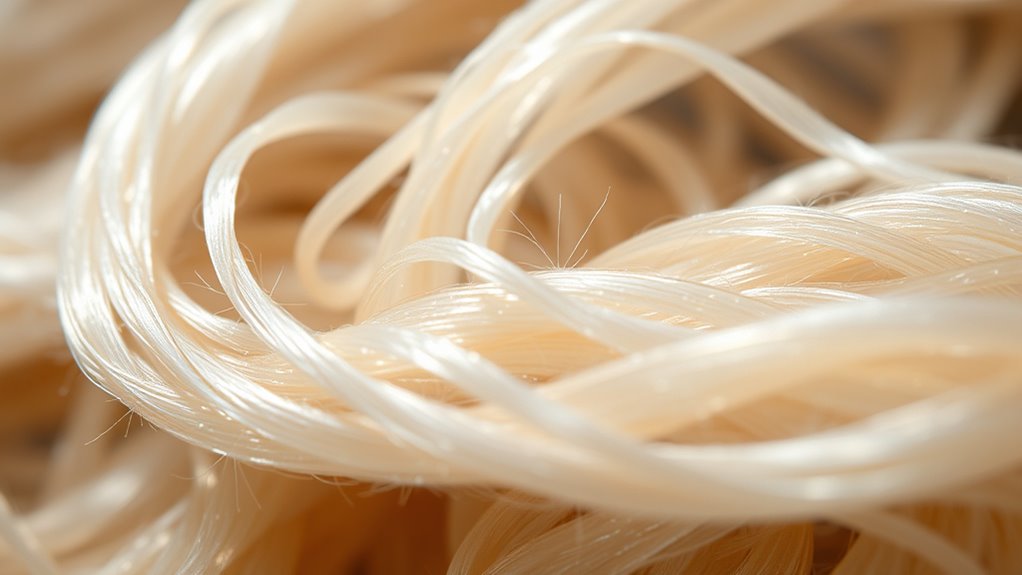
Your silk fibers have specific fibril orientation patterns that influence how light reflects off the surface. The size and distribution of scales also vary, shaping the rug’s sheen and texture. Understanding these structural details reveals why silk rugs have such a luminous quality. Additionally, the surface reflectivity of silk fibers plays a crucial role in their brilliance, with microscopic surface features contributing to their unique optical properties.
Fibril Orientation Patterns
The surface structure and scale arrangement of silk fibers reveal intricate fibril orientation patterns that considerably influence the rug’s sheen. These patterns determine how light reflects off the fibers, affecting dye penetration and fiber flexibility. When fibrils align uniformly, they create a smooth, glossy surface that enhances light play. Conversely, irregular orientations scatter light, dulling the sheen. Imagine:
- Fibrils arranged in tight, parallel lines shimmering under the surface
- Light bending around minute fibril angles, creating subtle gloss
- Dye molecules penetrating along aligned fibrils for vibrant colors
- Flexible fibril clusters allowing slight fiber movement, amplifying sheen
- Surface textures that catch and reflect light differently depending on fibril orientation
- Fibril alignment influences the degree of light reflection, contributing to the rug’s luminous qualities
- The surface structure of silk fibers also affects how environmental factors like humidity and wear impact their luminous qualities
- Variations in surface microstructure can lead to differences in how silk responds to environmental conditions, thus affecting its overall appearance
This microscopic arrangement shapes the visual depth and luster, making silk rugs uniquely mesmerizing. Additionally, the fiber’s surface structure influences how the fibers respond to environmental factors like humidity and wear, further affecting their luminous qualities.
Scale Size and Distribution
Variations in scale size and their distribution across silk fibers play a crucial role in shaping the rug’s surface appearance. The fiber diameter influences how large or small the scales appear, affecting how light interacts with the surface. Thinner fibers tend to have smaller, more uniform scales, creating a smooth sheen, while thicker fibers display larger, more varied scale sizes that enhance texture. The scale pattern, including the arrangement and overlap of scales, determines the fiber’s reflective qualities. A consistent scale pattern produces a uniform shine, whereas irregular patterns introduce depth and complexity. Additionally, understanding the surface structure of silk fibers helps explain how light is reflected and absorbed, impacting the rug’s overall luster and visual richness. The microstructural features of the fibers reveal how microscopic variations contribute to the overall visual effect. By examining these microstructural features, you can better understand how the fiber’s surface structure influences the overall luster and visual richness of the silk rug, especially considering the light play at the microscopic level. Recognizing the fiber surface morphology is essential for appreciating how subtle differences translate into visual diversity, as fiber composition also impacts the way light interacts with the surface.
Light Reflection and Refraction at the Microscale
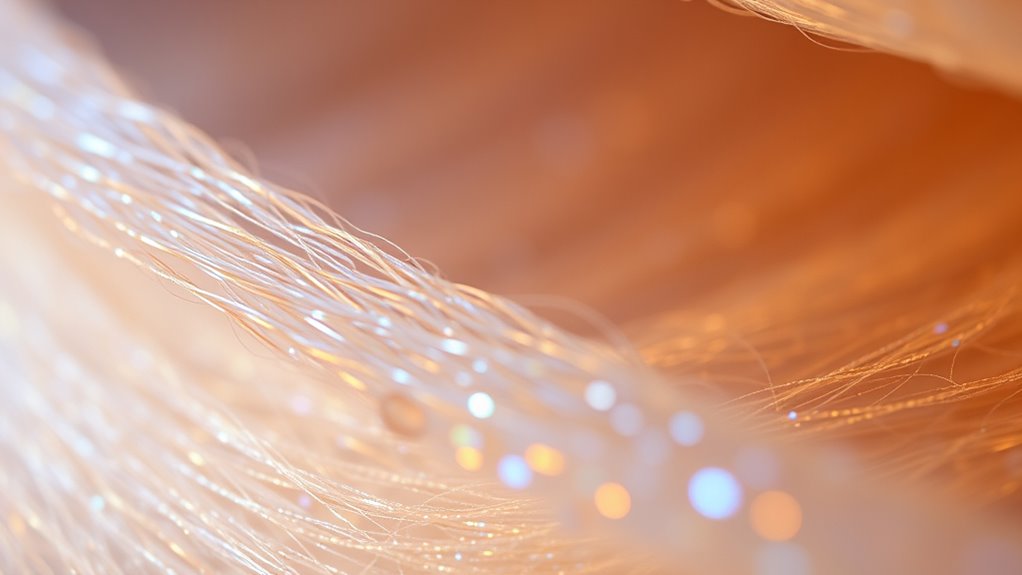
When light hits silk fibers, their tiny surface structures cause it to reflect and refract in unique ways. You can see how fiber surface dynamics influence the way light paths bend and scatter across the rug. Understanding these microscopic interactions reveals why silk rugs have such a mesmerizing sheen.
Fiber Surface Dynamics
At the microscopic level, fiber surfaces play a crucial role in how light interacts with silk rugs, shaping their appearance and sheen. The way light reflects and refracts depends on surface characteristics like smoothness, texture, and fiber flexibility. A smooth surface enhances reflection, giving the rug a luminous glow, while slight irregularities diffuse light for a softer sheen. Dye penetration influences surface reflectivity by altering how light interacts with the fiber’s interior and exterior. Fibers with high flexibility respond to subtle surface changes, affecting light scattering. Imagine:
- Shimmering highlights dancing along the fiber surface
- Light bending around tiny surface protrusions
- Variations in sheen caused by dye absorption patterns
- Flexed fibers creating dynamic light reflections
- Surface textures amplifying or dampening light play
These microscale dynamics, including fiber surface properties, are further affected by the fiber surface finish, which determines how light is reflected or absorbed at microscopic levels. Additionally, surface treatments can modify these interactions, enhancing the rug’s overall sheen and luster. Furthermore, understanding the light reflection and refraction at this scale can provide insights into the unique qualities of different silk fibers and their treatments.
Light Path Interactions
Light interacts with silk fibers on a microscale through reflection and refraction, shaping the rug’s luminous qualities. When light hits the silk, some reflects, creating shimmering highlights, while refracted light bends, revealing depth and complexity. This interplay influences dye absorption, affecting color vibrancy and brilliance. Over time, microbial degradation can alter fiber surfaces, changing how light interacts and diminishing sheen. These microscopic changes impact the rug’s visual appeal, revealing stories of age and preservation.
| Microstructure Effect | Emotional Impact |
|---|---|
| Reflection | Sparkling elegance, allure |
| Refraction | Depth, mystery |
| Dye absorption | Richness, vividness |
| Microbial degradation | Loss of luster, fading |
| Light interaction | Timeless beauty, fragile grace |
The Role of the Cuticle Layers in Light Interaction

The cuticle layers of silk fibers play a crucial role in how light interacts with the rug’s surface. They influence the optical properties by affecting the way light reflects, refracts, and scatters. The molecular arrangement within these layers determines how smoothly or unevenly light is transmitted or reflected. When light hits the surface, it encounters a layered structure that can enhance or diminish the rug’s sheen. Imagine:
- A shimmering surface with tiny, overlapping scales
- Light bouncing off smooth, aligned layers
- Variations in reflection caused by microscopic ridges
- Subtle iridescence from layered cuticles
- Light penetrating and scattering at different depths
These microscopic structures manipulate light, creating the luminous appearance that defines silk’s unique sheen, emphasizing the importance of the cuticle’s molecular arrangement in shaping optical properties.
How Fiber Orientation Affects Sheen
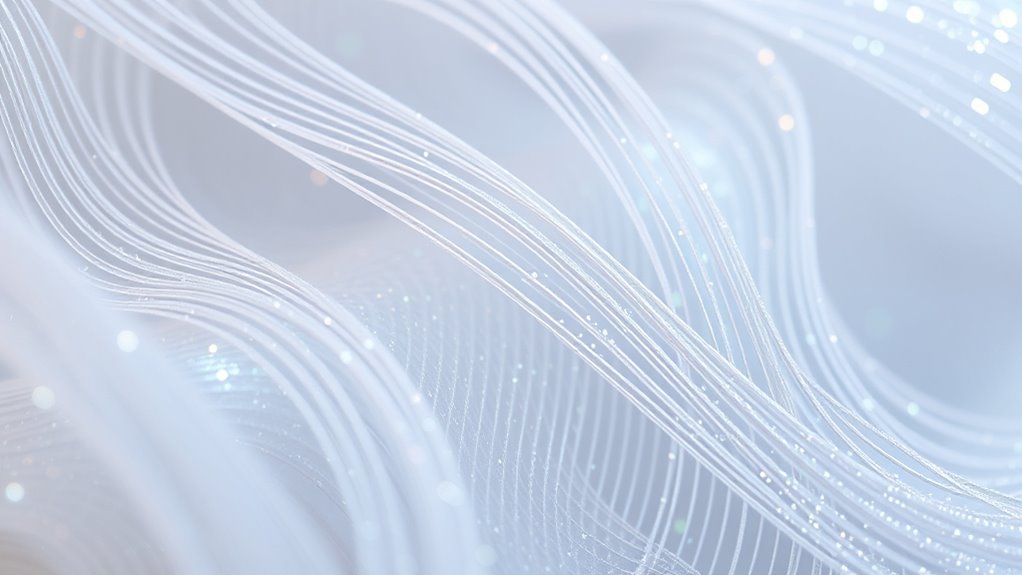
Fiber orientation markedly influences the sheen of a silk rug by determining how light interacts with its surface. When fibers are aligned uniformly, light reflects evenly, producing a consistent, lustrous appearance. Conversely, irregular fiber orientation scatters light, reducing sheen and creating a duller look. This alignment also impacts dye penetration; well-oriented fibers allow deeper, more even dye absorption, enhancing color vibrancy and sheen. Environmental effects, such as humidity and light exposure, can alter fiber orientation over time, affecting how light reflects and how the rug’s sheen appears. Proper fiber orientation not only enhances visual appeal but also contributes to the rug’s durability by resisting environmental stresses. Understanding this relationship helps you appreciate the nuanced interplay between fiber structure and the rug’s luminous qualities.
Variations in Sheen Due to Fiber Thickness
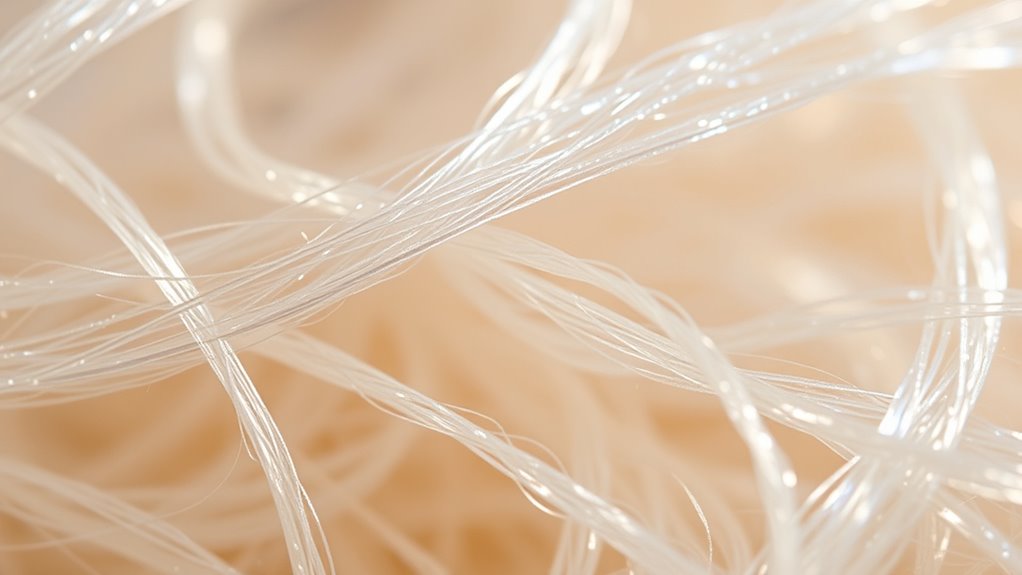
Variations in fiber thickness markedly influence the sheen of a silk rug by affecting how surface reflections occur. Thinner fibers tend to reflect light more uniformly, creating a softer, more luminous glow, while thicker fibers produce sharper highlights and deeper shadows. These differences impact dye penetration, with thinner fibers allowing dyes to spread evenly, enhancing vibrancy, and thicker fibers resisting dye absorption, resulting in varied color intensity. Fiber elasticity also plays a role; more elastic fibers can stretch slightly, affecting how light interacts with their surface. Visualize:
- Thin fibers shimmering with a gentle glow
- Thick fibers creating bold, vivid highlights
- Uneven dye absorption emphasizing fiber variation
- Elastic fibers subtly flexing under light
- Surface reflections shifting with fiber thickness changes
All these factors combine to produce the dynamic light play seen in silk rugs.
The Impact of Surface Smoothness on Light Play
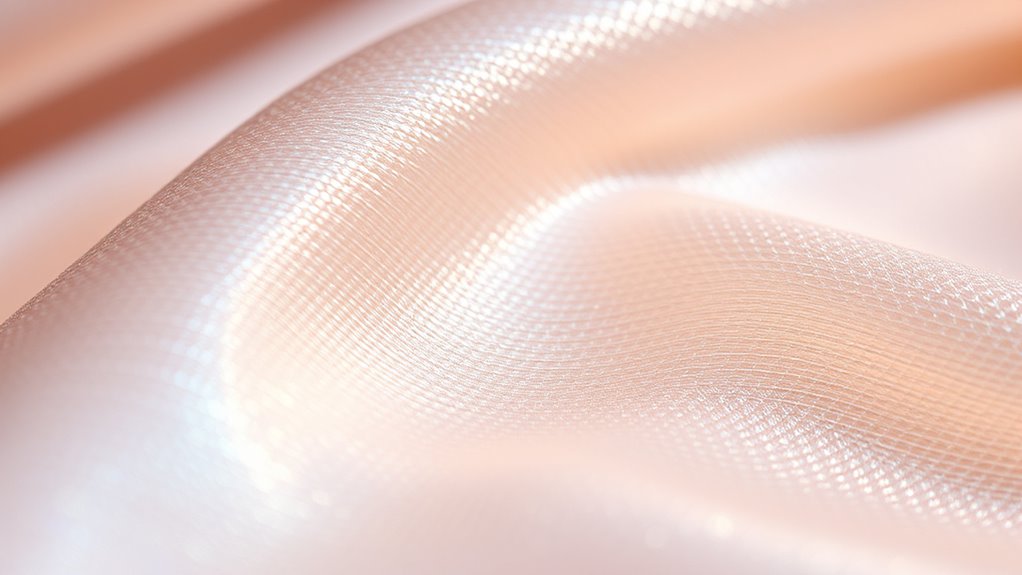
Surface smoothness directly influences how light interacts with a silk rug’s fibers, shaping the overall sheen and visual appeal. When the surface has low surface roughness, fibers reflect light more evenly, enhancing fiber gloss and creating a bright, lustrous appearance. Conversely, higher surface roughness causes light to scatter in multiple directions, dulling the sheen and reducing visual vibrancy. The microscopic bumps and irregularities on the fiber surface disrupt smooth light reflection, resulting in a less polished look. Maintaining surface smoothness is essential for maximizing the silk’s natural light play. By minimizing surface roughness, you allow the fibers to reflect light more uniformly, revealing the rug’s inherent luster and depth. This microscopic level of surface quality directly impacts the rug’s overall luminous appeal.
Comparing Natural Silk and Processed Fibers

The natural surface qualities of silk considerably influence its sheen, especially when compared to processed fibers. Natural silk’s smooth, uniform surface allows for deeper dye penetration, resulting in richer, more vibrant colors. Its high fiber elasticity enables it to retain shape and resist wear, maintaining sheen over time. Processed fibers, however, often have rougher surfaces due to chemical treatments, which reduce dye absorption and dull the visual effect. You might notice:
- A luminous glow from natural silk’s surface
- Enhanced dye uptake leading to vivid hues
- Greater flexibility and resilience in unprocessed fibers
- Less uniform light reflection in processed materials
- A softer, more natural texture in silk
These factors combine to give natural silk its distinctive sheen, making it more visually dynamic than many processed counterparts.
Visual Effects Created by Microstructural Features
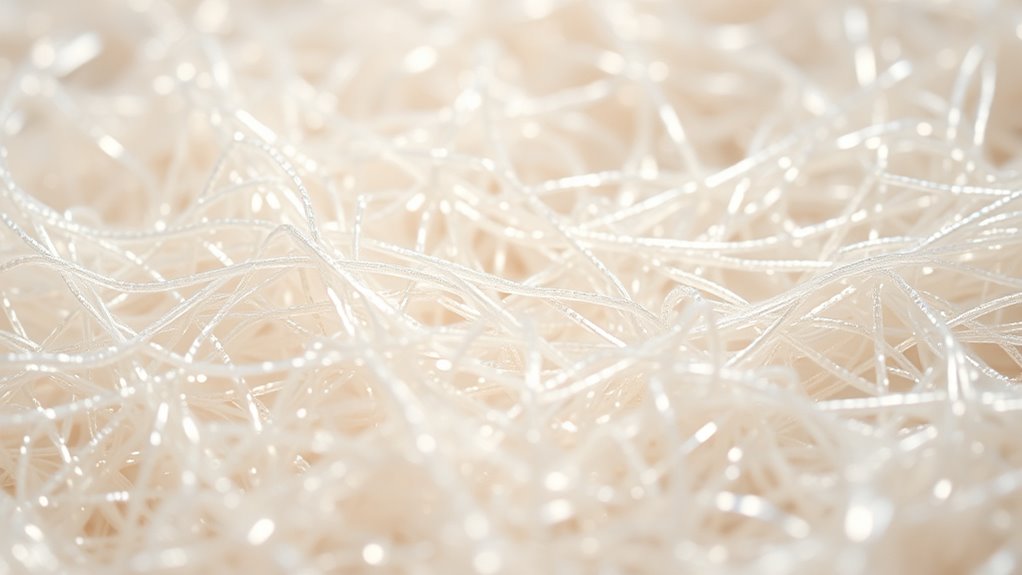
Microstructural features within silk fibers play a crucial role in creating its distinctive visual effects. The nanostructure intricacies of silk fibers influence how light interacts with the material, resulting in shimmering sheens and subtle color shifts. These microfeatures cause optical interference, where light waves overlap and reinforce or cancel each other, producing iridescent effects. As you observe a silk rug’s surface, you see how the nanoscale arrangement of fibrils and layers influences its luster. Variations in the fiber’s nanostructure can enhance or diminish specific light reflections, giving silk its unique glow. This interplay of light at the microscopic level contributes considerably to the vibrant, dynamic visual effects that make silk fibers so captivating to the eye.
Frequently Asked Questions
How Does Dye Absorption Influence Silk Rug Sheen at the Microscopic Level?
You might notice that dye absorption impacts a silk rug’s sheen by affecting fiber gloss at a microscopic level. As dye penetrates the fibers, it alters how light interacts with the surface. Deep dye penetration enhances the fiber’s gloss, creating a richer sheen, while superficial dye absorption can dull the fiber’s appearance. This microscopic change in dye penetration directly influences the visual depth and luster of your silk rug.
Can Environmental Factors Alter the Fibre’S Light Interaction Over Time?
Environmental factors, like degradation and chemical exposure, can markedly alter how your silk rug’s fibres interact with light over time. You might notice a duller sheen or uneven light reflection as these elements break down the fibre’s surface or affect dye properties. Protecting your rug from harsh environmental conditions helps preserve its microscopic fibre structure, ensuring it maintains its original light play and luminous quality longer.
Are There Differences in Sheen Between Silk Obtained From Different Silkworm Breeds?
You’ll notice that silk obtained from different silkworm breeds shows varying sheen levels. These differences stem from silk breed variations influenced by silkworm genetics, which affect fibre structure and light reflection. Some breeds produce silk with a more lustrous surface, while others have a softer sheen. Understanding these genetic factors helps you appreciate how silkworm genetics shape the optical qualities of silk, impacting its overall appearance and light play.
How Does Silk Fibre Aging Affect Its Microscopic Light Reflection Properties?
As silk fibers age, fiber degradation impacts their microscopic light reflection, making them appear duller. You’ll notice surface smoothness diminishes over time, causing irregular light play. This degradation creates micro-scratches and roughness, disrupting the fiber’s ability to reflect light uniformly. Consequently, aged silk shows less sheen, with diminished brilliance and a more matte appearance, revealing the effects of aging on its microscopic light reflection properties.
What Role Do Microscopic Imperfections Play in the Overall Rug Sheen Appearance?
Microscopic imperfections on the fiber surface markedly influence the rug’s sheen appearance. These imperfections cause light scattering, which diminishes the smooth, reflective quality of the silk. As a result, you notice a duller or uneven sheen. When fibers are flawless, light reflects uniformly, creating a vibrant shine. However, imperfections disrupt this process, leading to a less lustrous look, especially over time as fibers age and develop more surface irregularities.
Conclusion
By understanding the microstructure of silk fibers, you see how light dances on their surface, creating that mesmerizing sheen. Every twist and scale influences the visual magic, making each silk rug unique. Remember, beauty is in the details—like the saying, “The devil is in the details.” So, appreciate the intricate play of light, knowing it’s these tiny features that give silk its timeless allure and enchanting glow.

